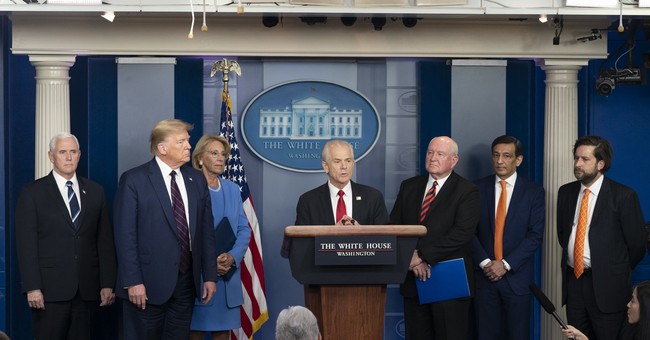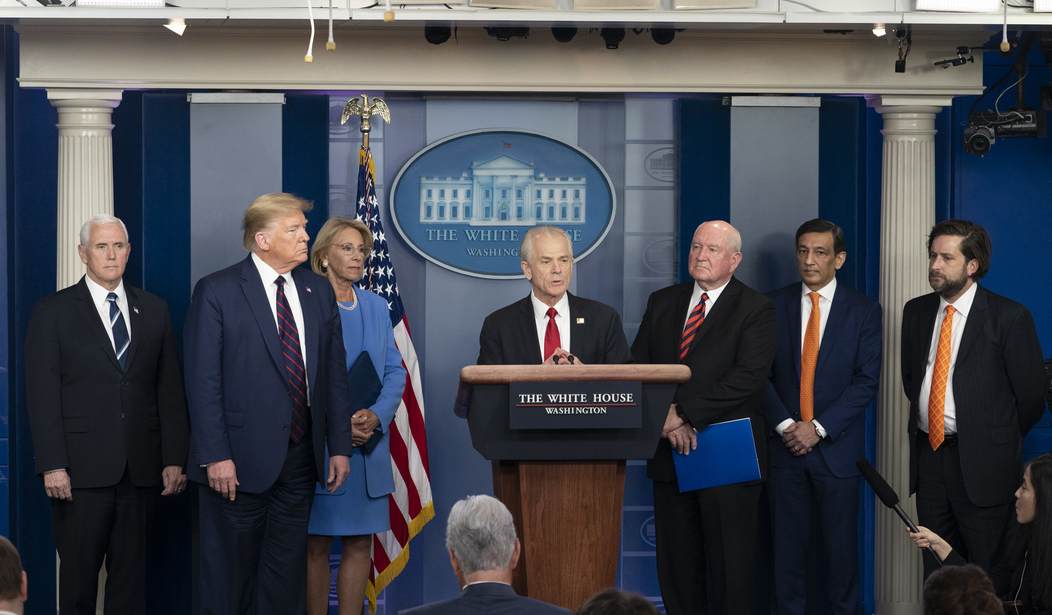
(Official White House by Joyce N. Boghosian)
The pandemic has done more than show the dangers of our Chinese reliance, it may have shown us the way back.
As we collectively try to deal with the aftermath of this viral outbreak one thing to look at as a potential positive result is the Trump administration looking into securing once again our own origination of medicines and basic medical supplies. It has been a dismaying and alarming reality coming to light that we have ceded much of the production of our needed items to the Chinese.
It has been estimated that Chinese pharmaceutical supplies are the source of more than 90 percent of our nation’s antibiotics, vitamin C, ibuprofen and hydrocortisone, as well as 70 percent of acetaminophen. Then you have the issue with that country also being the primary source of healthcare items, such as surgical masks, gloves, and scrubs. This became an issue as that nation began to grapple with the initial outbreak, leading to the Chi-Coms suspending exports as it needed to supply itself.
The encouraging news is Trump, via executive order, is seeking to more than encourage a return to US production of these and other similar goods. White House Director of Trade and Manufacturing Policy Peter Navarro has confirmed the steps being taken to ease our reliance on foreign nations on these crucial goods. Navarro, since named National Defense Production Act Policy Coordinator, wants to broaden this “Buy American” executive order so agencies are compelled to go with American-made pharmaceutical and medical equipment.
Earlier last month Navarro explained the administration’s intentions. “To help facilitate such production, the White House is also pushing for streamlined regulatory approvals for American-made products and more detailed labeling of the origin of products made offshore,” quoted the NY Times. This underscores the problem we are facing as the global leader in drug innovations, but a country that has turned over the manufacturing of those pharmaceuticals.
Apart from giving over our supply chain, there is the issue with the quality we receive. The fact that China was the point of origin of the virus and its subsequent shutdown meant a suspension of the production of those needed goods, there is a need to analyze what we receive. Look at the stories that have emerged of countries receiving sub-par goods, or even medical tests from China that were found to be completely ineffective. The country has essentially shown the need for us to, using the term most bandied about, decouple from so much Chi-Com reliance.
It will not be easy. In an example we can all relate to in some fashion, I just recently held the problem in my hands. In a desperate bid for outdoors and exercise, I compelled one child outside to play with his Christmas gift of a pickleball set. While playing I held in my hand a paddle ”made in China’’. This is not a product beyond the skill set of an American company. It was made of low-grade pressboard, simply cut into a paddle shape with two plastic slats glued to either end to comprise a handle, monochrome graphics printed, and a simple extruded wiffle ball. All told it might have been $0.50 worth of product, but still, it is cheaper to have it made abroad and shipped here.
For some of the proposed items the transition should be rather feasible, but with others, there are logistical economic hurdles that are in place, influences that have driven us to rely on China in the first place. Labor is vastly cheaper on the mainland, while the communist leadership is not as stringent about factory requirements and worker safety. Items such such as labor conditions, working hours, and compensation all favor China. And beyond that the country mostly does not bother itself with the environmental standards we impose on our corporations. All of this folds into the cost of the goods produced.
Navarro has detailed what they are targeting as far as the new policy they are fast-tracking in the White House. The executive order would cover more than 400 medicines considered essential, focusing on the “priority health care needs of the population.” Additional products include medical items made to protect against chemical and biological threats, radiation, nuclear fallout and infectious diseases. These are needed steps, highlighted by the crisis and exposes the folly of our decades of giving over control of these items to China.
The steps being taken are sweeping, they are impressive, and they are drastically needed. They are also being grossly underreported in the media. While the press is entirely focused on only negative portrayals and now avoiding coverage of the daily coronavirus briefings, this is the kind of information the White House is delivering. It is worth our while to side-step the media arbiters and take in the daily briefings on our own.















